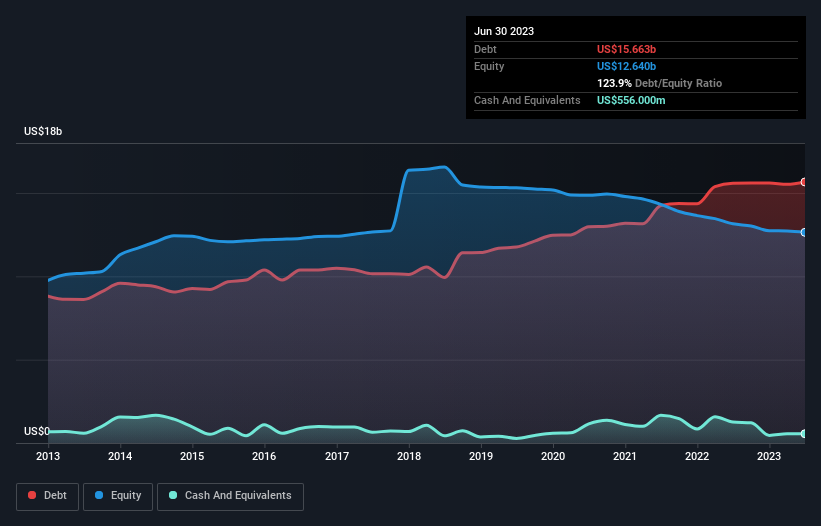- United States
- /
- Transportation
- /
- NYSE:NSC
We Think Norfolk Southern (NYSE:NSC) Is Taking Some Risk With Its Debt

Warren Buffett famously said, 'Volatility is far from synonymous with risk.' When we think about how risky a company is, we always like to look at its use of debt, since debt overload can lead to ruin. Importantly, Norfolk Southern Corporation (NYSE:NSC) does carry debt. But should shareholders be worried about its use of debt?
When Is Debt Dangerous?
Debt assists a business until the business has trouble paying it off, either with new capital or with free cash flow. If things get really bad, the lenders can take control of the business. While that is not too common, we often do see indebted companies permanently diluting shareholders because lenders force them to raise capital at a distressed price. Of course, debt can be an important tool in businesses, particularly capital heavy businesses. When we examine debt levels, we first consider both cash and debt levels, together.
View our latest analysis for Norfolk Southern
How Much Debt Does Norfolk Southern Carry?
As you can see below, Norfolk Southern had US$15.7b of debt, at June 2023, which is about the same as the year before. You can click the chart for greater detail. On the flip side, it has US$556.0m in cash leading to net debt of about US$15.1b.

How Healthy Is Norfolk Southern's Balance Sheet?
Zooming in on the latest balance sheet data, we can see that Norfolk Southern had liabilities of US$2.99b due within 12 months and liabilities of US$23.6b due beyond that. On the other hand, it had cash of US$556.0m and US$1.09b worth of receivables due within a year. So its liabilities outweigh the sum of its cash and (near-term) receivables by US$25.0b.
While this might seem like a lot, it is not so bad since Norfolk Southern has a huge market capitalization of US$45.6b, and so it could probably strengthen its balance sheet by raising capital if it needed to. However, it is still worthwhile taking a close look at its ability to pay off debt.
We measure a company's debt load relative to its earnings power by looking at its net debt divided by its earnings before interest, tax, depreciation, and amortization (EBITDA) and by calculating how easily its earnings before interest and tax (EBIT) cover its interest expense (interest cover). The advantage of this approach is that we take into account both the absolute quantum of debt (with net debt to EBITDA) and the actual interest expenses associated with that debt (with its interest cover ratio).
Norfolk Southern has a debt to EBITDA ratio of 2.6 and its EBIT covered its interest expense 6.7 times. This suggests that while the debt levels are significant, we'd stop short of calling them problematic. Notably Norfolk Southern's EBIT was pretty flat over the last year. We would prefer to see some earnings growth, because that always helps diminish debt. There's no doubt that we learn most about debt from the balance sheet. But ultimately the future profitability of the business will decide if Norfolk Southern can strengthen its balance sheet over time. So if you want to see what the professionals think, you might find this free report on analyst profit forecasts to be interesting.
But our final consideration is also important, because a company cannot pay debt with paper profits; it needs cold hard cash. So the logical step is to look at the proportion of that EBIT that is matched by actual free cash flow. Over the most recent three years, Norfolk Southern recorded free cash flow worth 52% of its EBIT, which is around normal, given free cash flow excludes interest and tax. This cold hard cash means it can reduce its debt when it wants to.
Our View
Even if we have reservations about how easily Norfolk Southern is capable of staying on top of its total liabilities, its interest cover and conversion of EBIT to free cash flow make us think feel relatively unconcerned. Looking at all the angles mentioned above, it does seem to us that Norfolk Southern is a somewhat risky investment as a result of its debt. Not all risk is bad, as it can boost share price returns if it pays off, but this debt risk is worth keeping in mind. The balance sheet is clearly the area to focus on when you are analysing debt. However, not all investment risk resides within the balance sheet - far from it. We've identified 1 warning sign with Norfolk Southern , and understanding them should be part of your investment process.
At the end of the day, it's often better to focus on companies that are free from net debt. You can access our special list of such companies (all with a track record of profit growth). It's free.
Valuation is complex, but we're here to simplify it.
Discover if Norfolk Southern might be undervalued or overvalued with our detailed analysis, featuring fair value estimates, potential risks, dividends, insider trades, and its financial condition.
Access Free AnalysisHave feedback on this article? Concerned about the content? Get in touch with us directly. Alternatively, email editorial-team (at) simplywallst.com.
This article by Simply Wall St is general in nature. We provide commentary based on historical data and analyst forecasts only using an unbiased methodology and our articles are not intended to be financial advice. It does not constitute a recommendation to buy or sell any stock, and does not take account of your objectives, or your financial situation. We aim to bring you long-term focused analysis driven by fundamental data. Note that our analysis may not factor in the latest price-sensitive company announcements or qualitative material. Simply Wall St has no position in any stocks mentioned.
About NYSE:NSC
Norfolk Southern
Engages in the rail transportation of raw materials, intermediate products, and finished goods in the United States.
Proven track record average dividend payer.

